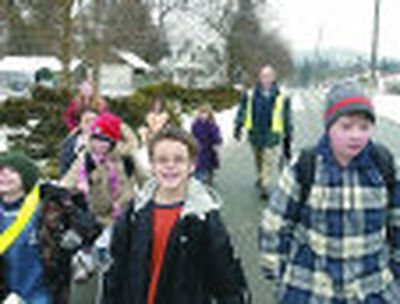Unity at risk

The Edgecliff walking school bus doesn’t have wheels that go round and round. Instead it scuds with the sound of children’s winter boots marching through roadside gravel down the tired streets of a blue-collar neighborhood.
Down 10th Avenue then Bradley Road, children leap from stubby concrete porches into the morning cold to catch “the bus” and greet its driver.
“Hey, Rick,” says Emily Deline between bites from a bologna sandwich on white bread.
Rick Scott is the driver. The reflective lettering on the volunteer’s blinding chartreuse safety vest states that this marching mob is indeed a school bus, one that shepherds kids eight blocks past busy streets through what was once a neighborhood beaten down by methamphetamine and drug-related crime. Neighborhood adults take turns shuttling kids 12 and younger to school three days a week, explains Scott. In doing so, they have a chance to talk about safety and community values.
“I think we really build relationships with these kids and we’ve kind of set up a structure to support them,” says Scott. “When they go on to middle school and high school, they still remember the things we taught them. They remember us.”
Right now, the biggest concern of this community sandwiched between Interstate 90 and the west slopes of Spokane Valley’s Dishman Hills is that the walking bus might be replaced by the real deal, one that will take the children out of the community for school. The move would take kids away from a network of adults that not only gives the children safe passage, but also mentors them, provides them with computers, issues hundreds of free books and takes a load off parents. Spokane Public Schools has suggested shuttering Edgecliff’s low-enrollment grade school, Pratt Elementary, to save roughly $500,000 a year.
“They’re going to kill the community,” says Sandy Lupe-Martin, and Edgecliff grandmother, because children are what keep the community together.
Lupe-Martin and Scott are both involved in the local Sheriff’s Community Oriented Policing Effort, or SCOPE. The organization consists mostly of volunteers old enough to be grandparents. It has created nearly all of the child-related programs the neighborhood offers. And they know how hard it is to remain in touch with neighbors once children are no longer in the picture. A neighbor two blocks away may only be known as young Billie’s mom, they agree, but without Billie she’s a stranger.
The children on Scott’s walking bus route are too young to remember what Edgecliff was like before residents banded together in the late 1990s to reclaim their neighborhood. Low-rent drug addicts looking for something to hock pillaged area homes, desecrated a neighborhood cemetery and turned local playgrounds into pharmaceutical wastebaskets. Things didn’t turn around until SCOPE volunteers launched an intense neighborhood patrol program and encouraged residents to clean up the community.
“Our neighborhood cleanups collected over 120 tons of garbage,” says Scott, who joined SCOPE after his garage was broken into.
Theft is down. Drug crimes are down. Graffiti is almost unheard of and the community that rated worst in most crime categories is no longer No. 1 in any. The number of neighbors connected to one another through children is way up.
“I’ve been around adults pretty much my whole life,” says Matthew Grayson, a walking bus regular. He rattles off seven Edgecliff adults he knows by name. Although he doesn’t realize it, three of them are SCOPE members and Scott who walks with Grayson to school every Thursday doesn’t even make the list.
As the bus reaches the halfway point, young Nathan Falzone meets the group on a corner and bolts for the front of the pack. Scott delays the child just long enough to drape a fluorescent safety sash around the boy’s collar.
“One of the things we teach these kids is it’s safer to walk together,” Scott says. “They do it even when we’re not with them.”